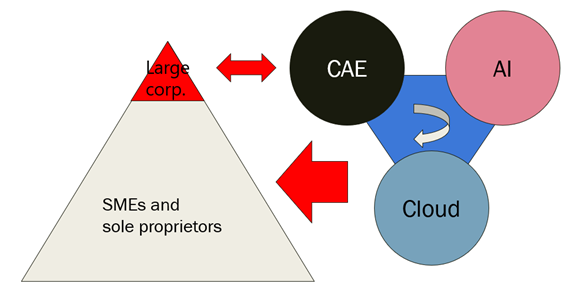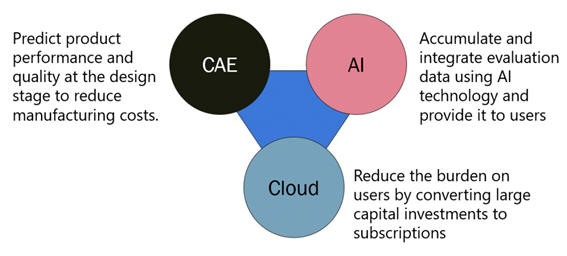This section highlights Astraea Software’s Activity as a pioneer in 3D Artificial Intelligence .
First, we will explain what the problems and limitations with current AI technologies, the necessity for 3D Artificial Intelligence, and the potential application and how we can use 3D AI.
In industries such as manufacturing and construction, the use of 3D data has become the standard. Technologies like CAD (Computer-Aided Design), CAM (Computer-Aided Manufacturing), and CAE (Computer-Aided Engineering) are all fundamentally based on 3D shapes created by advanced 3D CAD systems. These technologies are crucial for designing, simulating, and manufacturing complex products and structures.
However, the current AI technologies face significant limitations when it comes to recognizing and processing 3D shapes. Traditional AI models are primarily designed to handle 2D data, such as images and text, and struggle to interpret the complexities of 3D data. This gap poses a critical challenge for industries that rely heavily on 3D data for their operations.
The urgency to address this limitation cannot be overstated. As industries continue to advance and the demand for more sophisticated and efficient processes grows, the need for AI that can seamlessly integrate with 3D data becomes increasingly pressing. Without this capability, companies risk falling behind in innovation and efficiency, potentially losing their competitive edge.
To fully leverage the potential of AI in these fields, it is essential to develop AI models that can accurately recognize, interpret, and utilize 3D shapes. Addressing this limitation is not just a matter of technological advancement; it is a critical step towards ensuring the continued growth and competitiveness of industries that form the backbone of our economy. Therefore, when introducing AI to these technologies, it is essential for AI to recognize 3D shapes.
In conclusion AI is essential for several reasons : Efficiency, Speed, Scalability and Cost Reduction.
We will talk about comparison between text-based AI, 2D data AI and 3D data AI.
Take database search, one of the main functions of AI, as an example.
With text-based AI, it is necessary to search for similar shapes by handing out textual information such as part numbers. However, it is necessary for a person to prepare the text information of the clue in advance assuming the search content, which requires careful preparation and enormous effort. Also, the maintenance requires a lot of effort.
If AI can recognize the 3D shape, it can search the database for a shape similar to the search target. Therefore, all you need to do in advance is to prepare only 3D shape data such as CAD.

However, since there is no technology to recognize 3D shapes as they are, alternative measures have been taken, such as taking snapshots of the 3D shape from about 20 different viewpoints and having the 2D AI recognize the 3D shape from a group of 2D images.
This technology is an extension of 2D image recognition, and as the 3D shape becomes more complex, there are many cases where the hole shape is shadowed and not displayed on the screen, making it difficult to maintain recognition accuracy.

With the 3D AI technology that we have been researching and developing, the shape can be recognized directly from the nodes (vertices, coordinate positions) and elements (node connection information) that make up the 3D shape. Therefore, the shape of the hole etc. is not hidden, the dimensions can be grasped from the coordinate position, and it can be used for classification and matching of 3D shapes. Also, since it has coordinate positions, it is possible to generate new 3D shapes.
Furthermore, the 3D shape captured by the 3D scanner can be recognized as it is, and it can be classified and matched, and can be used in various scenes of the design process.

3D AI technology offers transformative potential across multiple sectors. Here are some key areas where 3D AI can be applied.
In the manufacturing industry, 3D AI can significantly enhance processes such as CAD (Computer-Aided Design), CAM (Computer-Aided Manufacturing), and CAE (Computer-Aided Engineering). By utilizing surrogate models, 3D AI can streamline simulations and optimizations, leading to more efficient and accurate design and production workflows. This helps in reducing costs, improving product quality, and accelerating time-to-market.
Throughout the product life cycle, 3D AI can play a crucial role in various stages, from design to disposal. For instance, it can be used to search and classify 3D models, making it easier to manage and retrieve design data. Matching algorithms can help in identifying similar parts or components, facilitating reuse and reducing the need for redundant designs. This enhances overall efficiency and sustainability in product development and management.
In the realm of design, 3D AI can drive innovation by enabling the synthesis of new models. By combining elements from existing designs, AI can generate novel and creative solutions that push the boundaries of traditional design processes. This capability is particularly valuable in industries such as automotive, aerospace, and consumer products, where unique and optimized designs are critical for competitive advantage.
not only limited with areas mention above, there is several others application like:
Our activity goal is to integrate CAE, AI, and cloud technologies and to infiltrate technologies from large companies to SMEs.
We will permeate the advanced technology cultivated in large companies into every corner of the industrial structure and strongly support the entire manufacturing industry all over the world.

We will create new added value by integrating 3D AI technology with CAE technology, which has already been used for decades at manufacturing design sites.
Furthermore, we provide a system with excellent operability, efficiency, and cost while reducing the burden on users with cloud technology.

For the features of our main technology in 3D Artificial Intelligence, please refer to Overview of the 3D Artificial Intelligence Model.
Our ARIES product line-up has expanded from three to six innovative products. For more information about our offerings product, please refer to ARIES Product Series.